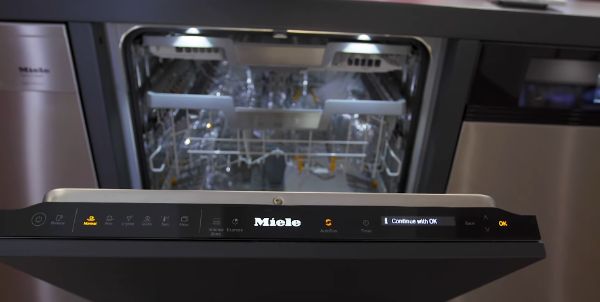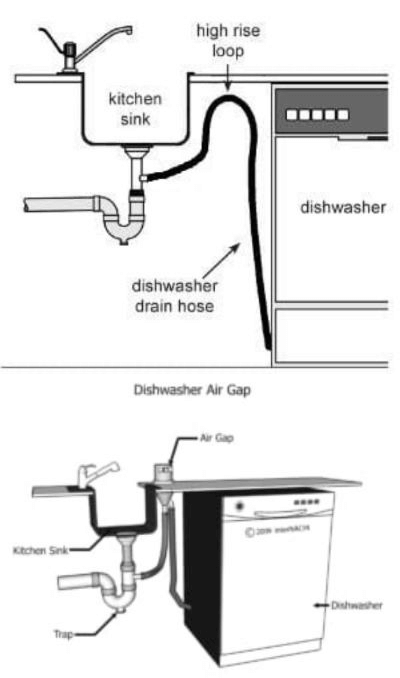Proper drainage is a critical aspect of dishwasher operation, as it ensures the removal of wastewater and prevents potential backups and contamination. When installing a dishwasher, two common methods are employed to address drainage concerns: the dishwasher high loop and the air gap.
In this article, we will explore these two approaches, their purposes, and the key factors to consider when choosing the most suitable option for your dishwasher setup.
Table of Contents
Dishwasher High Loop: An Effective, Space-Saving Solution
A dishwasher high loop is a simple and efficient method for preventing backflow and maintaining proper drainage. Here’s what you need to know:
- Function: A high loop is created by securing the dishwasher drain hose to the underside of the countertop or sink, forming a loop that sits higher than the dishwasher drain connection or garbage disposal. This loop prevents wastewater from flowing back into the dishwasher due to gravity or a sudden increase in water pressure.
- Installation: To implement a high loop, ensure that the drain hose is securely attached to the underside of the countertop or sink. It should then descend to connect to the drain or garbage disposal. The loop should be as high as possible, ideally reaching the underside of the countertop or sink, to effectively prevent backflow.
- Advantages: The high loop method is simple, cost-effective, and space-efficient. It eliminates the need for additional plumbing components and provides a reliable barrier against backflow, protecting your dishwasher from potential contamination.
Air Gap: A Reliable Mechanical Barrier
An air gap is another method commonly used to prevent wastewater backflow and maintain dishwasher drainage. Here’s what you should know:
- Function: An air gap is a physical device that creates an unobstructed gap of air between the dishwasher drain hose and the receiving drain pipe or garbage disposal. This gap serves as a mechanical barrier, preventing any wastewater from flowing back into the dishwasher.
- Installation: The air gap is typically installed on the sink or countertop, adjacent to the faucet. It consists of a vertical cylinder or cap that connects to the dishwasher drain hose, while the other end connects to the receiving drain pipe. The air gap should be installed in compliance with local plumbing codes and guidelines.
- Advantages: Air gaps provide an extra layer of protection against backflow, as they create a visible physical break between the dishwasher and the drainage system. They are particularly useful in situations where local plumbing codes require their installation.
Choosing the Right Option
Consider the following factors when deciding between a dishwasher high loop and an air gap:
- Local Codes and Regulations: Check local plumbing codes and regulations to determine if there are specific requirements for dishwasher drainage in your area. Some jurisdictions mandate the use of air gaps, while others allow the high loop method.
- Space and Aesthetics: Assess the available space and the overall aesthetics of your kitchen. A high loop is more discreet and space-efficient, as it involves securing the drain hose under the countertop or sink. On the other hand, an air gap is a visible component that sits on the sink or countertop.
- Backup Risk: Evaluate the potential risk of backups and backflow in your plumbing system. If there is a higher likelihood of water pressure fluctuations or potential blockages, an air gap may provide an added layer of security.
- Maintenance: Consider the ease of maintenance and cleaning for each option. A high loop requires periodic inspection and cleaning to ensure it remains unobstructed, while an air gap may need occasional maintenance to prevent clogs or blockages.
Conclusion
Ensuring proper dishwasher drainage is essential for maintaining a hygienic and functional kitchen. Whether you choose the dishwasher high loop or air gap method, both approaches serve the purpose of preventing wastewater backflow and protecting your dishwasher from potential contamination.
The dishwasher high loop offers a straightforward and space-saving solution. By securing the drain hose under the countertop or sink, it forms a loop that sits higher than the drain connection. This setup effectively prevents backflow without the need for additional plumbing components. The high loop method is cost-effective and easy to install, making it a popular choice for many households.
On the other hand, the air gap provides a visible and mechanical barrier against backflow. Installed on the sink or countertop, it creates a visible break between the dishwasher drain hose and the receiving drain pipe. Air gaps are often required by local plumbing codes and regulations. They offer an extra layer of protection and can be particularly beneficial in areas prone to water pressure fluctuations or potential blockages.
When deciding between the high loop and air gap methods, consider factors such as local codes and regulations, available space, aesthetics, backup risk, and maintenance requirements. Ensure compliance with any specific requirements mandated by your local jurisdiction.
Regular maintenance and inspection are crucial regardless of the method you choose. Periodically check the high loop or air gap for any blockages or obstructions that may hinder proper drainage. Clean and clear the components as needed to maintain optimal performance.
In conclusion, both the dishwasher high loop and air gap methods are effective in preventing wastewater backflow and maintaining proper dishwasher drainage. Choose the option that aligns with local codes, suits your space and aesthetic preferences, and provides the level of protection required for your specific plumbing system. By ensuring efficient drainage, you can enjoy clean dishes and a well-functioning dishwasher in your kitchen.


